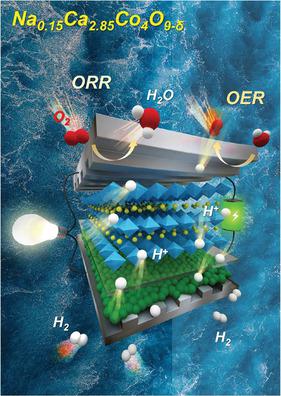当前位置:
X-MOL 学术
›
Adv. Energy Mater.
›
论文详情
Our official English website, www.x-mol.net, welcomes your
feedback! (Note: you will need to create a separate account there.)
Understanding the Highly Electrocatalytic Active Mixed Triple Conducting NaxCa3–xCo4O9–δ Oxygen Electrode Materials
Advanced Energy Materials ( IF 24.4 ) Pub Date : 2022-11-27 , DOI: 10.1002/aenm.202202999 Kwangho Park 1 , Hohan Bae 2 , Hyun‐Kyu Kim 3 , In‐Gyu Choi 3 , Minkyeong Jo 1 , Gwang‐Min Park 1 , Muhammad Asif 1 , Aman Bhardwaj 2 , Kug‐Seung Lee 4 , Yeong‐Cheol Kim 3 , Sun‐Ju Song 2 , Eric D. Wachsman 5 , Jun‐Young Park 1
Advanced Energy Materials ( IF 24.4 ) Pub Date : 2022-11-27 , DOI: 10.1002/aenm.202202999 Kwangho Park 1 , Hohan Bae 2 , Hyun‐Kyu Kim 3 , In‐Gyu Choi 3 , Minkyeong Jo 1 , Gwang‐Min Park 1 , Muhammad Asif 1 , Aman Bhardwaj 2 , Kug‐Seung Lee 4 , Yeong‐Cheol Kim 3 , Sun‐Ju Song 2 , Eric D. Wachsman 5 , Jun‐Young Park 1
Affiliation

|
Despite their high electrocatalytic activity for oxygen electrode reactions, the low phase stability and high thermal expansion of perovskite structured materials have created difficulties in cell fabrication scale-up and long-term operational stability of reversible ceramic cells. Herein, an exceptionally high-performance electrocatalyst is presented based on a misfit-layered structure, Na0.15Ca2.85Co4O9–δ (NCCO). NCCO cells enable exceptional fuel cell performance down to 400 °C, with peak power densities of 0.18–5.15 W cm−2 at 400–800 °C, as well as electrolysis performance of minus current density 5.96–15.07 A·cm−2 (at 1.4 V) at 600–750 °C, exceeding the values of all previously described reversible (oxygen and proton) ceramic cells. Furthermore, the durability of NCCO cells is demonstrated for over 900 h at high current densities of 1 and 2 A cm−2 in fuel cells and –0.5 and –4 A cm−2 electrolysis cell modes under load cycle and constant current reversible operation, respectively. Doping with basic monovalent Na+ ions in the Ca-site in Ca3Co4O9+δ generates a high density of extra charge carrier species with the increased Co oxidation state and facilitates the proton uptake and diffusion properties of misfit-layered materials. This finding can deliver a new opportunity to develop innovative bifunctional oxygen electrode catalysts, while providing more favorable reaction pathways for the diffusion of charged species.
中文翻译:

了解高电催化活性混合三重导电 NaxCa3–xCo4O9–δ 氧电极材料
尽管它们对氧电极反应具有高电催化活性,但钙钛矿结构材料的低相稳定性和高热膨胀性给可逆陶瓷电池的电池制造放大和长期运行稳定性带来了困难。在此,基于失配层状结构 Na 0.15 Ca 2.85 Co 4 O 9–δ (NCCO)提出了一种非常高性能的电催化剂。NCCO 电池可在低至 400 °C 的温度下实现出色的燃料电池性能,在 400-800 °C 时的峰值功率密度为 0.18-5.15 W cm -2,负电流密度的电解性能为 5.96-15.07 A·cm -2(在 1.4 V 时)在 600–750 °C,超过了所有先前描述的可逆(氧气和质子)陶瓷电池的值。此外,NCCO 电池的耐久性在燃料电池中 1 和 2 A cm -2的高电流密度以及负载循环和恒定电流可逆操作下的 –0.5 和 –4 A cm -2电解电池模式下被证明超过 900 小时,分别。在Ca 3 Co 4 O 9+δ的Ca位掺杂碱性单价Na +离子产生高密度的额外电荷载流子物种,并增加 Co 氧化态,并促进失配层状材料的质子吸收和扩散特性。这一发现可以为开发创新的双功能氧电极催化剂提供新的机会,同时为带电物质的扩散提供更有利的反应途径。
更新日期:2022-11-27
中文翻译:

了解高电催化活性混合三重导电 NaxCa3–xCo4O9–δ 氧电极材料
尽管它们对氧电极反应具有高电催化活性,但钙钛矿结构材料的低相稳定性和高热膨胀性给可逆陶瓷电池的电池制造放大和长期运行稳定性带来了困难。在此,基于失配层状结构 Na 0.15 Ca 2.85 Co 4 O 9–δ (NCCO)提出了一种非常高性能的电催化剂。NCCO 电池可在低至 400 °C 的温度下实现出色的燃料电池性能,在 400-800 °C 时的峰值功率密度为 0.18-5.15 W cm -2,负电流密度的电解性能为 5.96-15.07 A·cm -2(在 1.4 V 时)在 600–750 °C,超过了所有先前描述的可逆(氧气和质子)陶瓷电池的值。此外,NCCO 电池的耐久性在燃料电池中 1 和 2 A cm -2的高电流密度以及负载循环和恒定电流可逆操作下的 –0.5 和 –4 A cm -2电解电池模式下被证明超过 900 小时,分别。在Ca 3 Co 4 O 9+δ的Ca位掺杂碱性单价Na +离子产生高密度的额外电荷载流子物种,并增加 Co 氧化态,并促进失配层状材料的质子吸收和扩散特性。这一发现可以为开发创新的双功能氧电极催化剂提供新的机会,同时为带电物质的扩散提供更有利的反应途径。

































 京公网安备 11010802027423号
京公网安备 11010802027423号